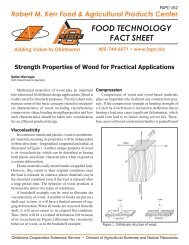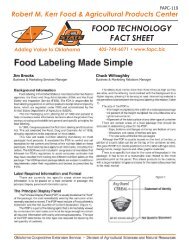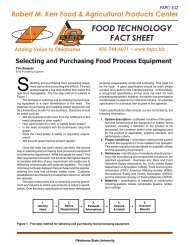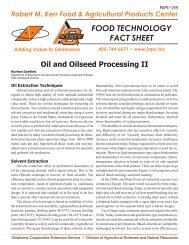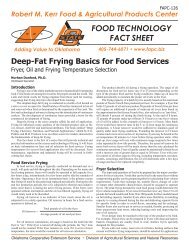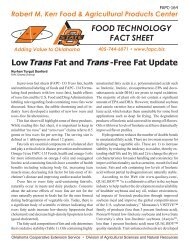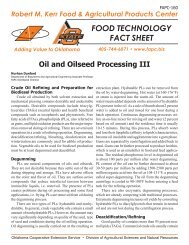Spring/Summer 2010 - Robert M. Kerr Food & Agricultural Products ...
Spring/Summer 2010 - Robert M. Kerr Food & Agricultural Products ...
Spring/Summer 2010 - Robert M. Kerr Food & Agricultural Products ...
You also want an ePaper? Increase the reach of your titles
YUMPU automatically turns print PDFs into web optimized ePapers that Google loves.
news<br />
By Mandy Gross<br />
FAPC Manager of Communications Services<br />
mandy.gross@okstate.edu<br />
T<br />
he Institute of<br />
Medicine released a report<br />
by an expert committee recommending<br />
the <strong>Food</strong> and Drug Administration<br />
set standards for salt added to<br />
processed foods and prepared meals.<br />
The report indicates Americans,<br />
on average, consume 50 percent more<br />
sodium than the maximum amount<br />
that is recommended. When compared<br />
to the amounts considered adequate<br />
for daily consumption, the level of<br />
sodium being consumed by Americans<br />
equates to almost 125 percent the levels<br />
recommended.<br />
“The committee’s task was to consider<br />
what would be the best means<br />
to reduce sodium levels in the U.S.<br />
diet,” said Christina DeWitt, FAPC<br />
food chemist. “It was determined that<br />
voluntary methods would not be sufficient<br />
as there had been more than 40<br />
years of voluntary<br />
efforts to reduce<br />
sodium, and data<br />
clearly shows in<br />
that time period<br />
sodium intake rose<br />
steadily over a period<br />
of years and has<br />
remained steady at<br />
the current levels for<br />
nearly a decade.”<br />
The committee also<br />
reviewed the sources of sodium when<br />
making its recommendations. The<br />
research reviewed by the committee<br />
indicated most sodium in the diet is<br />
found in the processed foods and prepared<br />
meals Americans purchase in<br />
grocery stores and restaurants, DeWitt<br />
said.<br />
“The report cites industry has<br />
made many efforts to reduce sodium,<br />
but in a hearing before the committee<br />
by industry representatives, it was<br />
clearly illustrated that efforts to reduce<br />
sodium was many times thwarted by<br />
industry lacking a ‘level playing field’<br />
with higher level sodium products,”<br />
DeWitt said.<br />
It also was noted anecdotally that<br />
current regulations for claims placed<br />
Report released<br />
to reduce salt<br />
in processed,<br />
prepared food<br />
on products with reduced or lower sodium<br />
make it difficult for industry to<br />
create products that are not obviously<br />
different in flavor to the consumer<br />
when compared to their higher sodium<br />
counterpart.<br />
It was suggested claims of “reduced”<br />
or “low” sodium now send<br />
“red flags” to the consumer causing<br />
them to equate those products with<br />
“poor” taste. The committee’s solution<br />
was to suggest the FDA set standards<br />
for the salt added to foods to “level the<br />
playing field” for sodium reduction<br />
efforts.<br />
In addition, because the consumer<br />
easily notes large reductions in sodium,<br />
it was suggested by the committee<br />
that sodium reductions be done gradually,<br />
DeWitt said.<br />
“The report cited research that<br />
indicates, depending on the product,<br />
small reductions can often be made<br />
without consumers noticing a difference<br />
in product flavor,” she said. “The<br />
report, therefore, suggests the best way<br />
to reduce the sodium levels consumed<br />
in the U.S. is to set standards for the<br />
salt added to processed and prepared<br />
meals and reduce the salt allowed in a<br />
step-wise gradual manner.”<br />
<strong>Spring</strong>/<strong>Summer</strong> <strong>2010</strong> | 7




